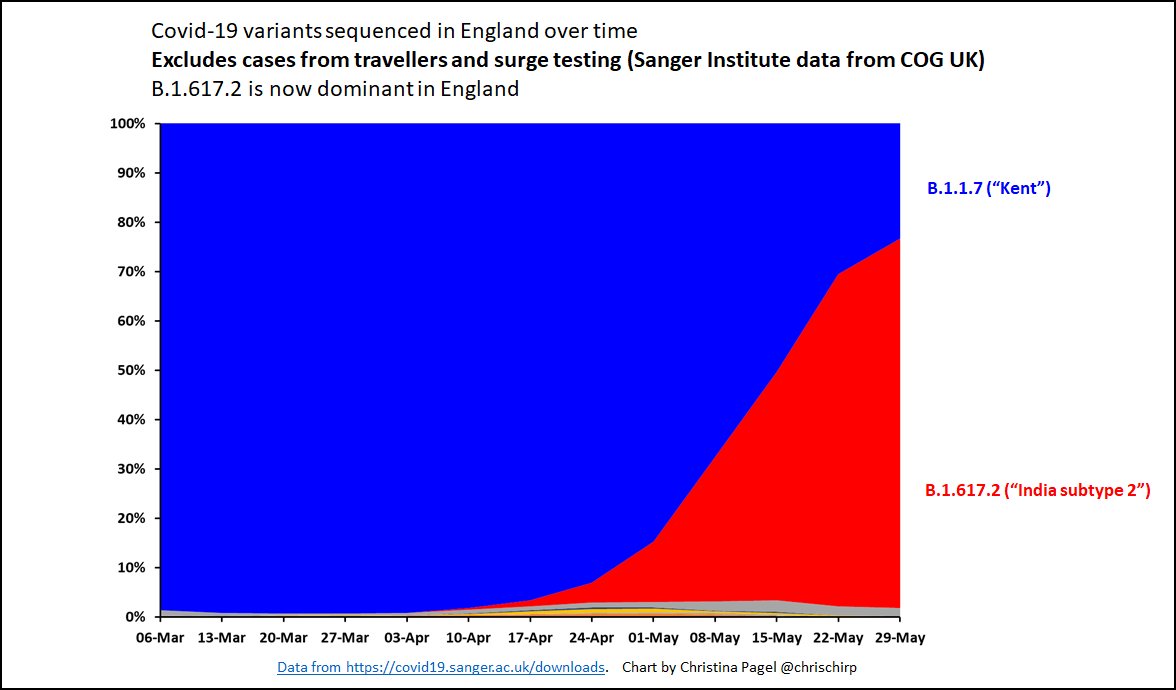
THREAD latest on B.1.617.2 variant in England:
B.1.617.2 (1st discovered in India) is now dominant in England. Here is a thread summarising latest PHE report and Sanger local data.
TLDR: it is NOT good news. 1/7
B.1.617.2 (1st discovered in India) is now dominant in England. Here is a thread summarising latest PHE report and Sanger local data.
TLDR: it is NOT good news. 1/7
Firstly, B.1.617.2 is now dominant in England.
This data excludes traveller data and surge testing as much as possible.
In absolute numbers, B.1.617.2 ("India") overtook B.1.1.7 ("Kent") about 15 May.
PHE report estimates a few days earlier. 2/7

This data excludes traveller data and surge testing as much as possible.
In absolute numbers, B.1.617.2 ("India") overtook B.1.1.7 ("Kent") about 15 May.
PHE report estimates a few days earlier. 2/7


B.1.617.2 is now dominant in almost every region of England.
Even NE and Yorks are catching up very fast. 3/7
Even NE and Yorks are catching up very fast. 3/7

The PHE report last week also looked at "secondary attack rates" - chance that a close contact of a confirmed case will also test positive (NB contacts with no symptoms not necessarily tested)
They estimate that person with B.1.617.2 is 67% more likely to infect a contact. 4/7
They estimate that person with B.1.617.2 is 67% more likely to infect a contact. 4/7

There are still reasons why this might be higher other than just higher transmissibility - but note this estimate has got *higher* since previous report, as more data has come in.
Also, SAGE's bad scenarios start from 40% more transmissible variant.
Also, SAGE's bad scenarios start from 40% more transmissible variant.
https://twitter.com/Dr_D_Robertson/status/1396568757892489217?s=205/7
Reported cases in England have risen 27% in last week. Hospital admissions to 26 May have risen 15%.
Cases are going up steeply in many local authorities.
Cases are going up steeply in many local authorities.
https://twitter.com/julesmchamish/status/1399059877226504194?s=206/7
We need to stop obsessing about 21st June and start worrying about where we are *now* and how we can get cases down *now*.
Oh and massively discourage international travel - not least to protect other, less vaccinated, countries from this variant.
Oh and massively discourage international travel - not least to protect other, less vaccinated, countries from this variant.
https://twitter.com/chrischirp/status/1398955136756617219?s=207/7
PS:
PHE report here:
assets.publishing.service.gov.uk/government/upl…
Sanger data here:
covid19.sanger.ac.uk/downloads
I'm also kinda sick of people minimising this the whole time. The speed of spread has been so quick.
PHE report here:
assets.publishing.service.gov.uk/government/upl…
Sanger data here:
covid19.sanger.ac.uk/downloads
I'm also kinda sick of people minimising this the whole time. The speed of spread has been so quick.
PS they don't exclude surge testing any more.now that b.1.617.2 is dominant
• • •
Missing some Tweet in this thread? You can try to
force a refresh















